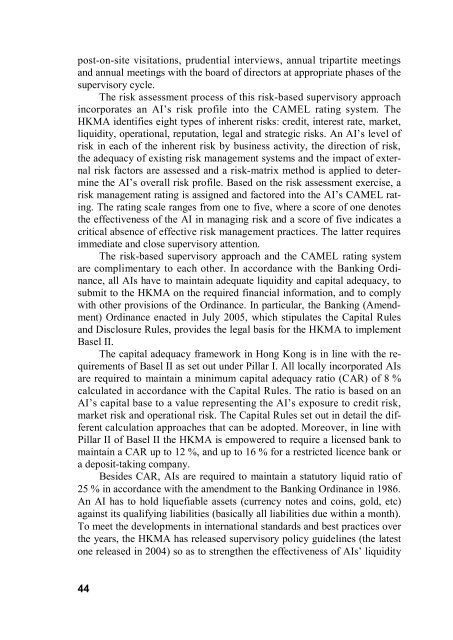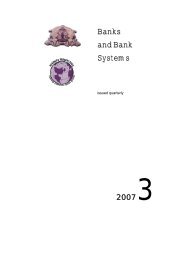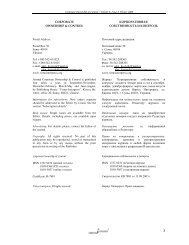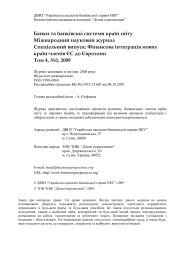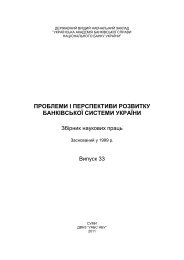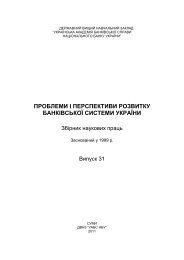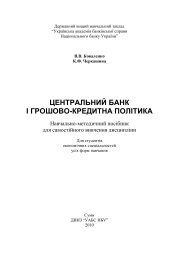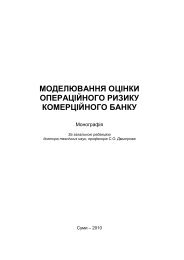BASEL II: PROBLEMS AND USAGE
BASEL II: PROBLEMS AND USAGE
BASEL II: PROBLEMS AND USAGE
Create successful ePaper yourself
Turn your PDF publications into a flip-book with our unique Google optimized e-Paper software.
post-on-site visitations, prudential interviews, annual tripartite meetings<br />
and annual meetings with the board of directors at appropriate phases of the<br />
supervisory cycle.<br />
The risk assessment process of this risk-based supervisory approach<br />
incorporates an AI’s risk profile into the CAMEL rating system. The<br />
HKMA identifies eight types of inherent risks: credit, interest rate, market,<br />
liquidity, operational, reputation, legal and strategic risks. An AI’s level of<br />
risk in each of the inherent risk by business activity, the direction of risk,<br />
the adequacy of existing risk management systems and the impact of external<br />
risk factors are assessed and a risk-matrix method is applied to determine<br />
the AI’s overall risk profile. Based on the risk assessment exercise, a<br />
risk management rating is assigned and factored into the AI’s CAMEL rating.<br />
The rating scale ranges from one to five, where a score of one denotes<br />
the effectiveness of the AI in managing risk and a score of five indicates a<br />
critical absence of effective risk management practices. The latter requires<br />
immediate and close supervisory attention.<br />
The risk-based supervisory approach and the CAMEL rating system<br />
are complimentary to each other. In accordance with the Banking Ordinance,<br />
all AIs have to maintain adequate liquidity and capital adequacy, to<br />
submit to the HKMA on the required financial information, and to comply<br />
with other provisions of the Ordinance. In particular, the Banking (Amendment)<br />
Ordinance enacted in July 2005, which stipulates the Capital Rules<br />
and Disclosure Rules, provides the legal basis for the HKMA to implement<br />
Basel <strong>II</strong>.<br />
The capital adequacy framework in Hong Kong is in line with the requirements<br />
of Basel <strong>II</strong> as set out under Pillar I. All locally incorporated AIs<br />
are required to maintain a minimum capital adequacy ratio (CAR) of 8 %<br />
calculated in accordance with the Capital Rules. The ratio is based on an<br />
AI’s capital base to a value representing the AI’s exposure to credit risk,<br />
market risk and operational risk. The Capital Rules set out in detail the different<br />
calculation approaches that can be adopted. Moreover, in line with<br />
Pillar <strong>II</strong> of Basel <strong>II</strong> the HKMA is empowered to require a licensed bank to<br />
maintain a CAR up to 12 %, and up to 16 % for a restricted licence bank or<br />
a deposit-taking company.<br />
Besides CAR, AIs are required to maintain a statutory liquid ratio of<br />
25 % in accordance with the amendment to the Banking Ordinance in 1986.<br />
An AI has to hold liquefiable assets (currency notes and coins, gold, etc)<br />
against its qualifying liabilities (basically all liabilities due within a month).<br />
To meet the developments in international standards and best practices over<br />
the years, the HKMA has released supervisory policy guidelines (the latest<br />
one released in 2004) so as to strengthen the effectiveness of AIs’ liquidity<br />
44


